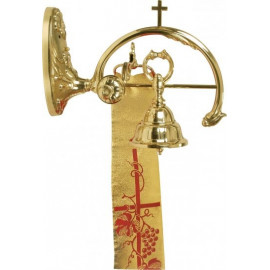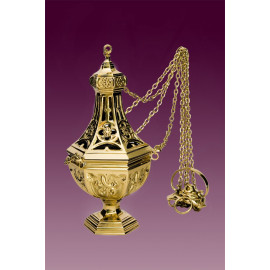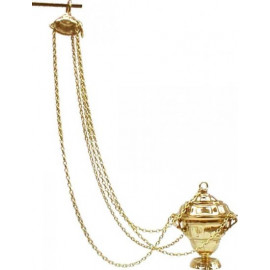No products
Product successfully added to your shopping cart
There are 0 items in your cart. There is 1 item in your cart.
Thurible, Boat, & Spoon
- Altar Bell and Gong
- Candle Snuffer
- Candlestick
- Catholic Pyx
- Chalices
- Church wall lamps
- Ciborium
- Crosses and Crucifix
- Cruets & Trays
- Holy Water Font
- Holy Water Pot
- Missal Stand
- Monstrance Tabor
- Monstrances
- Offering Baskets
- Oil Stock
- Patens
- Reliquaries
- Sanctuary Bells
- Sanctuary Lamp
- Sprinkler
- Thurible, Boat, & Spoon
- Travel Liturgy & Mass Kit
Viewed products
A thurible is a metal censer suspended from chains, in which incense is burned during worship services. It is used in Christian churches including the Roman Catholic, Eastern Orthodox, Anglican, Lutheran, and Methodist churches. The thurible is usually made of silver, brass, or gold-plated, and consists of a metal bowl into which the charcoal and incense are placed, and a lid pierced by holes to allow the fragrance from the incense to escape. The workings of a thurible are quite simple. Each thurible consists of a censer section, chains (typically three or four, although single-chain thuribles also exist), a metal ring around the chains (used to lock the lid of the censer section in place), and usually (although not always) a removable metal crucible in which the burning charcoals are placed. Many thuribles are supplied with a stand, allowing the thurible to be hung safely when still hot, but not in use. The thurible is swung back and forth by the priest or deacon during the liturgy to spread the smoke of the incense throughout the church. The use of incense and the thurible is symbolic of the prayers of the faithful rising to heaven.
A thurible is a metal censer suspended from chains, in which incense is burned during worship services. It is used in Christian churches including the Roman Catholic, Eastern Orthodox, Anglican, Lutheran, and Methodist churches. The thurible is usually made of silver, brass, or gold-plated, and consists of a metal bowl into which the charcoal and incense are placed, and a lid pierced by holes to allow the fragrance from the incense to escape. The workings of a thurible are quite simple. Each thurible consists of a censer section, chains (typically three or four, although single-chain thuribles also exist), a metal ring around the chains (used to lock the lid of the censer section in place), and usually (although not always) a removable metal crucible in which the burning charcoals are placed. Many thuribles are supplied with a stand, allowing the thurible to be hung safely when still hot, but not in use. The thurible is swung back and forth by the priest or deacon during the liturgy to spread the smoke of the incense throughout the church. The use of incense and the thurible is symbolic of the prayers of the faithful rising to heaven.
Thurible, Boat, & Spoon There are 50 products.
The Enigmatic Charm of the Church Thurible
The church thurible, a vessel of ancient tradition and deep spiritual significance, stands as a testament to the enduring rituals that connect the physical to the divine. This metal censer, suspended from chains, is not just a container but a bridge between worlds, carrying the prayers of the faithful to the heavens with every billow of fragrant smoke.
What Exactly is a Church Thurible?
A church thurible is a liturgical instrument used during worship services to burn incense.
This practice, deeply rooted in Christian traditions, symbolizes the prayers of the faithful rising to God.
The thurible itself is a metal censer, often ornately designed, suspended by chains, allowing it to be swung to disperse the incense smoke.
It's a common sight in various Christian denominations, including Roman Catholic, Eastern Orthodox, and Anglican churches, among others.
The Historical Journey of the Thurible
The use of incense in religious rituals predates Christianity, with its origins tracing back to ancient Judaism and even earlier pagan rites.
The Christian adoption of incense burning, symbolized through the thurible, was a means to sanctify the worship space, honor the sacred, and represent the prayers of the saints ascending to heaven.
Over centuries, the design and use of the thurible have evolved, reflecting the artistic and theological currents of the times.
The Artistic Evolution of Thuribles
From the simple early Christian designs to the elaborate Gothic and Baroque styles, thuribles have been crafted to be as aesthetically pleasing as they are functional.
Some, like the famous Botafumeiro in Santiago de Compostela Cathedral, Spain, are monumental in scale and serve as both liturgical instruments and works of art.
Others are more modest but no less significant in their role in worship.
The Thurible in Modern Worship
Despite the modern age's technological advances, the church thurible remains a vital part of Christian liturgy.
Its use during significant moments of the service—such as the Eucharist, processions, and funerals—underscores the continuity of tradition within the church.
Moreover, the sensory experience of incense burning, with its distinctive aroma and the sight of smoke rising, adds a profound depth to worship, engaging the faithful in a multisensory act of devotion.
FAQs About Church Thuribles
Q: Can anyone operate a thurible during services?
A: Typically, the thurifer, an altar server designated for this task, is responsible for handling the thurible. However, priests or deacons may also use it during specific parts of the service.
Q: Are thuribles used in all Christian denominations?
A: While prevalent in many high church traditions such as Roman Catholic, Eastern Orthodox, and Anglican, thuribles are less common in Protestant denominations that do not emphasize ceremonial worship.
Q: What types of incense are burned in a thurible?
A: Various blends of incense can be used, often containing frankincense, myrrh, and other aromatic resins. The choice of incense may vary based on liturgical season or specific religious tradition.
Q: How is the thurible cleaned?
A: Cleaning a thurible involves removing the residue of burnt incense and charcoal and polishing the metal to maintain its appearance. This task is usually performed by the sacristan or another church official responsible for maintaining liturgical items.
The Unseen Impact of the Thurible
Beyond its physical presence and use in worship, the church thurible carries symbolic weight.
It represents the communal prayers of the faithful, the transcendence of the divine, and the continuity of tradition across generations.
In the swinging of the thurible and the ascent of incense smoke, worshippers find a tangible expression of their faith and a reminder of the spiritual dimension that pervades their lives.
The church thurible, then, is more than just a liturgical instrument.
It is a vessel of faith, a work of art, and a link to the divine, embodying the mystery and beauty of Christian worship.



